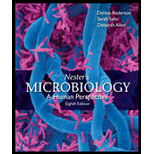
Concept explainers
To review:
The cause of upper respiratory infection through eye contamination.
Introduction:
The respiratory system of the humans is one of the prime biological system wherein exchange of gases and breathing process is accomplished. The lungs are known to be the primary organ, which participates in this system. This system is segregated into upper and lower respiratory system.
Explanation of Solution
The upper respiratory system involves the nose, the nasal passage, trachea, larynx, and pharynx. The nasal passage comprises cilia, which are finger-like projections that block the microorganisms to enter into the lungs. The infection usually is a common cold, which is caused by a virus. The symptoms involve the runny nose, sore throat, cough, congestion, and sneezing.
The microorganisms can enter the respiratory system either via nose, throat, or eye. From the nose, they can directly escape and enter the respiratory system; from the throat, they may enter via the mouth and enter the respiratory system; or from eyes, the organisms can enter the surface of the eye and enter the nasopharynx passage via the nasolacrimal duct. Therefore, eye contamination may lead to the infection in the upper region of the respiratory system.
Therefore, it can be concluded that the pathogens can enter from the surface of the eye and enter the respiratory system via the nasolacrimal duct.
Want to see more full solutions like this?
Chapter 21 Solutions
Nester's Microbiology: A Human Perspective
- What symbolic and cultural behaviors are evident in the archaeological record and associated with Neandertals and anatomically modern humans in Europe beginning around 35,000 yBP (during the Upper Paleolithic)?arrow_forwardDescribe three cranial and postcranial features of Neanderthals skeletons that are likely adaptation to the cold climates of Upper Pleistocene Europe and explain how they are adaptations to a cold climate.arrow_forwardBiology Questionarrow_forward
- ✓ Details Draw a protein that is embedded in a membrane (a transmembrane protein), label the lipid bilayer and the protein. Identify the areas of the lipid bilayer that are hydrophobic and hydrophilic. Draw a membrane with two transporters: a proton pump transporter that uses ATP to generate a proton gradient, and a second transporter that moves glucose by secondary active transport (cartoon-like is ok). It will be important to show protons moving in the correct direction, and that the transporter that is powered by secondary active transport is logically related to the proton pump.arrow_forwarddrawing chemical structure of ATP. please draw in and label whats asked. Thank you.arrow_forwardOutline the negative feedback loop that allows us to maintain a healthy water concentration in our blood. You may use diagram if you wisharrow_forward
- Give examples of fat soluble and non-fat soluble hormonesarrow_forwardJust click view full document and register so you can see the whole document. how do i access this. following from the previous question; https://www.bartleby.com/questions-and-answers/hi-hi-with-this-unit-assessment-psy4406-tp4-report-assessment-material-case-stydu-ms-alecia-moore.-o/5e09906a-5101-4297-a8f7-49449b0bb5a7. on Google this image comes up and i have signed/ payed for the service and unable to access the full document. are you able to copy and past to this response. please see the screenshot from google page. unfortunality its not allowing me attch the image can you please show me the mathmetic calculation/ workout for the reult sectionarrow_forwardIn tabular form, differentiate between reversible and irreversible cell injury.arrow_forward
- Surgical Tech For Surgical Tech Pos CareHealth & NutritionISBN:9781337648868Author:AssociationPublisher:CengageUnderstanding Health Insurance: A Guide to Billin...Health & NutritionISBN:9781337679480Author:GREENPublisher:Cengage
 Human Physiology: From Cells to Systems (MindTap ...BiologyISBN:9781285866932Author:Lauralee SherwoodPublisher:Cengage Learning
Human Physiology: From Cells to Systems (MindTap ...BiologyISBN:9781285866932Author:Lauralee SherwoodPublisher:Cengage Learning





